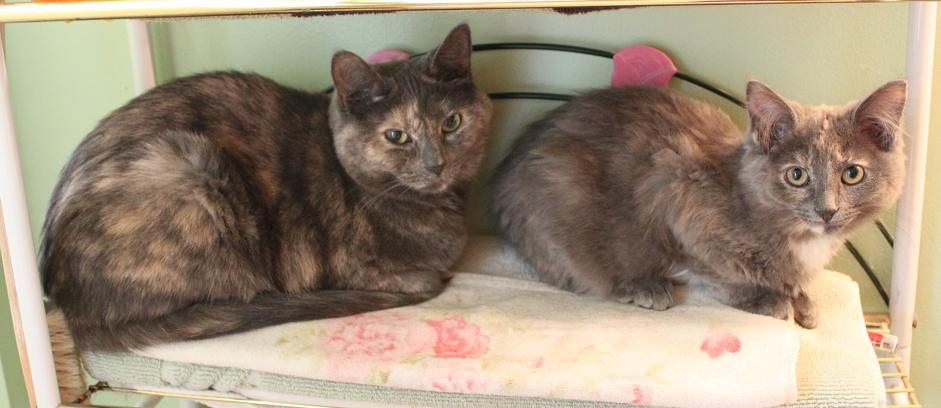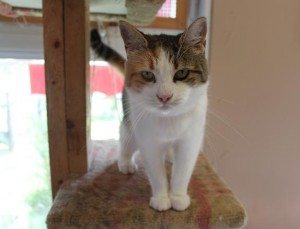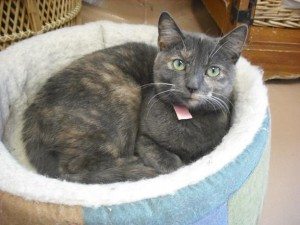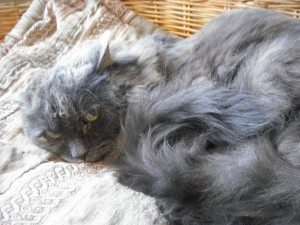
The mention of any dog breed among animal lovers provokes discussions of the quirks and interesting traits that breed has. While popular cat breeds like Persians or Siamese do appear in animal shelters far more frequently than they should, we more often find ourselves identifying the resident cats by colour and not fancy-shmancy breeds. Nonetheless, every cat lover seems to have a lot to say about personalities based on fur colour: “Orange tabbies are the friendliest cats ever!” “Black cats are so fun, always looking to play!” “Tortoiseshells and calicos are so… emotional.”
A quick Google search on tortoiseshell personalities showed me that this is apparently not some phenomenon that occurs exclusively at the SPCA Montérégie. Tri-colour cats really do have a reputation for being especially emotional, so much so that some people have even coined a term for it: tortitude. I think I’m going to have to integrate that term into my vocabulary, because having recently had three tortoiseshells chez nous—two fosterlings and a perma-cat—it’s easy to see that there is a special something that tri-colour cats have.
So how can I explain “tortitude”? Like any breed of any species, tortoiseshells and calicos can’t be given one generalized description. Even if we separated them according to classic torties versus dilute torties, longhaired versus shorthaired, it still wouldn’t work. Instead, I’m going to fill this post with some of the memorable tortoiseshells and calicos I have met during my years of volunteering. Those who know tri-colour cats might find themselves thinking, “Oh yeah, that’s such a tortie thing, alright!” while other might think I’m nuts for liking such complicated cats.
 Charline is the main inspiration for this post. We had fostered her from August until just last week, when she left for her forever home. If I want to sum her personality up in few words, “sensitive” and “expressive” come to mind. I happened to be at the shelter the day that Charline arrived, at which time she expressed the fact that she was sensitive to this change by curling up into a motionless ball and drooling like a faucet. She was pitiful and there was no way we could leave her there, so to our home she came. Her appreciation was expressed through lots of growling and hissing—except when she met my father, for whom she purred and rolled over onto her back to show her belly. Wait, what? And whenever she met a new person, the same thing happened: default friendliness. We were baffled. After the many months she spent with us, Charline mostly gained confidence in me, but there was still some doubt present. When I stop to think about it, I believe it was rooted in that one day she was at the shelter. Whose face did she see after being put in a cage? Mine. Who squeezed her into a too-small transporter? Me. Who left her totally alone in a strange room all day? Me. Charline is an intelligent cat, and I think she held that day against me. She has fortunately forgiven her adopter for the stressful ride home and is now a happy only cat.
Charline is the main inspiration for this post. We had fostered her from August until just last week, when she left for her forever home. If I want to sum her personality up in few words, “sensitive” and “expressive” come to mind. I happened to be at the shelter the day that Charline arrived, at which time she expressed the fact that she was sensitive to this change by curling up into a motionless ball and drooling like a faucet. She was pitiful and there was no way we could leave her there, so to our home she came. Her appreciation was expressed through lots of growling and hissing—except when she met my father, for whom she purred and rolled over onto her back to show her belly. Wait, what? And whenever she met a new person, the same thing happened: default friendliness. We were baffled. After the many months she spent with us, Charline mostly gained confidence in me, but there was still some doubt present. When I stop to think about it, I believe it was rooted in that one day she was at the shelter. Whose face did she see after being put in a cage? Mine. Who squeezed her into a too-small transporter? Me. Who left her totally alone in a strange room all day? Me. Charline is an intelligent cat, and I think she held that day against me. She has fortunately forgiven her adopter for the stressful ride home and is now a happy only cat.
 And now for something a little different. While Charline’s contradicting behaviour could be explained by considering her experience, the same cannot be said for Solena. Queen of the room she lives in at the shelter, Solena is best described as… well… a word-that-is-better-suited-for-an-unsterilized-female-dog. Oddly enough, there’s something endearing about a cat this spiteful. Cats almost always have reasons for being “touchy”, but Solena just seems to like it. She will approach you to be patted, and she will enjoy it—for a little while. When enjoyment time is up, she will clearly give you a look, or make a little sound of disapproval; if you ignore or fail to notice it, smack! So her odds at adoption are probably not the greatest, but since we all love Solena (for some inexplicable reason), she’ll continue getting patted when she wants it and will always get a small bowl of canned food to herself because the other cats don’t dare intrude on Solena’s turf.
And now for something a little different. While Charline’s contradicting behaviour could be explained by considering her experience, the same cannot be said for Solena. Queen of the room she lives in at the shelter, Solena is best described as… well… a word-that-is-better-suited-for-an-unsterilized-female-dog. Oddly enough, there’s something endearing about a cat this spiteful. Cats almost always have reasons for being “touchy”, but Solena just seems to like it. She will approach you to be patted, and she will enjoy it—for a little while. When enjoyment time is up, she will clearly give you a look, or make a little sound of disapproval; if you ignore or fail to notice it, smack! So her odds at adoption are probably not the greatest, but since we all love Solena (for some inexplicable reason), she’ll continue getting patted when she wants it and will always get a small bowl of canned food to herself because the other cats don’t dare intrude on Solena’s turf.
Lili displayed the emotional side of calicos in a different manner. She was seven years old when her owner left her and her orange-and-white sister at the shelter because she was moving. The two cats immediately staked their claim on the hiding spot under the couch-of-sorts in the big cat room. While her sister stayed healthy despite being scared, Lili fell into a horrible depression after a month or so. She hardly had the will to stand up. By being moved into a cage for a couple of weeks, Lili got plenty of one-on-one time and special attention to her eating/drinking habits. As you can see from the pictures above, Lili’s short vacation made all the difference for her – the day her bad shape was noticed, a week later, and a couple of months later in the cat room. Just as long as Lili received some love regularly, much like she probably did in her old home, she could stay strong. While I worried that Lili would feel down again after her sister’s adoption, she kept her spirits up and got adopted.
 While Lili was a housecat who thrived from human attention, the stray cat Romina was less certain about people. This little dilute tortie was very conflicted when put in the cattery at the shelter: she was quite young and open to the idea of interaction with humans, but also been unsocialized long enough to be wary of them. The result was a lot of jerky, skittish movements accompanied by happy purring and confused attempts at cuddling. As you can imagine, it was quite endearing, so it is no surprise that Romina was adopted within a couple of weeks.
While Lili was a housecat who thrived from human attention, the stray cat Romina was less certain about people. This little dilute tortie was very conflicted when put in the cattery at the shelter: she was quite young and open to the idea of interaction with humans, but also been unsocialized long enough to be wary of them. The result was a lot of jerky, skittish movements accompanied by happy purring and confused attempts at cuddling. As you can imagine, it was quite endearing, so it is no surprise that Romina was adopted within a couple of weeks.
 To close up these memories, I have to mention Vanille. Never before and never since have I seen a cat as horrified as Vanille. The picture of her to the left is an accurate representation of Vanille’s week in the cattery. Wherever you placed her, Vanille would just curl into that ball and not move an inch. When she was taken in a person’s arms, Vanille would let out a mournful meow that made it clear: if this cat did not find a foster home fast, she would let herself die. A foster family mercifully had space for Vanille, and though it took many long months, Vanille gained some much-needed confidence thanks to their patience. The tiny tortie still had to contend with the other resident cats who didn’t quite understand or appreciate her reserved, submissive character. Just as it was with my Charline, it was a long time before the perfect cat-free home came along and offered Vanille the sanctuary she needed.
To close up these memories, I have to mention Vanille. Never before and never since have I seen a cat as horrified as Vanille. The picture of her to the left is an accurate representation of Vanille’s week in the cattery. Wherever you placed her, Vanille would just curl into that ball and not move an inch. When she was taken in a person’s arms, Vanille would let out a mournful meow that made it clear: if this cat did not find a foster home fast, she would let herself die. A foster family mercifully had space for Vanille, and though it took many long months, Vanille gained some much-needed confidence thanks to their patience. The tiny tortie still had to contend with the other resident cats who didn’t quite understand or appreciate her reserved, submissive character. Just as it was with my Charline, it was a long time before the perfect cat-free home came along and offered Vanille the sanctuary she needed.
I could so easily go on to write about many other tri-colour cats I’ve seen, but too many anecdotes may bury that common theme, that tortitude. Those sensitive, expressive, and intelligent traits I saw in Charline are a good part of what make tri-colour cats so distinct. They can be the feline counterparts of those humans we call “unsocial” – they may lash out or they may hide, and they may have the most beautiful minds of their kind. For anyone else who has worked with rescue cats, or who just has experience with cats, have you found tri-colour cats to be somehow different from others? What unique personality traits can be applied more to one colour of cat than others?
 Montreal Dog Blog Montreal's Online Dog Park
Montreal Dog Blog Montreal's Online Dog Park





